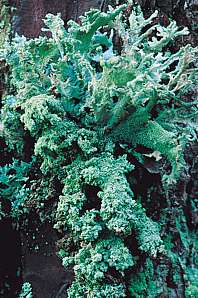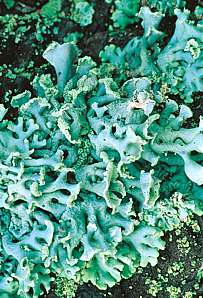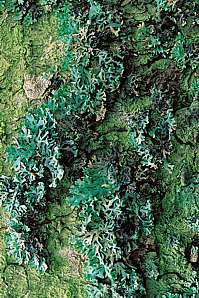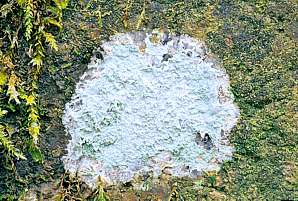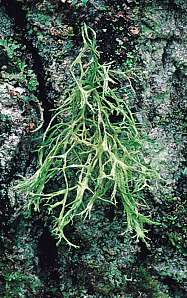|
LICHENS
|
||||||||||||
Text:
|
Monitoring
Lichens showing a great adaptation to extreme environmental conditions (they endure low temperatures, strong winds and prolonged lack of rain) are conspicuous with the especially large sensibility to the changes of habitat conditions called out by the natural and anthropogenic factors. Lichens are generally used to estimate the degree of air pollution with the sulphur dioxide. Even small concentration of air pollution can cause a far going changes in the biology of lichens or even can lead to their death. At first we observe dying out the bushy lichens, mainly Usnea hirta, then the leafy lichens and at the end the shell-like lichens.
In 1998 Wigry National Park became acquainted with the monitoring system of lichens. Its aim is a periodic inspection of condition of lichens, observation of changes taking place in the species composition of lichens under the influence of different factors of natural and anthropogenic origin and prognosis of these of changes based on the level of population and species.
12 species of lichens were chosen to observe the changes taking places in the environment of the Park.
Bryoria fuscescens A bushy thallus reminding delicate hanging threads up to a dozen or so and more centimeters of length. It grows on the bark of trees, more seldom on the rotten or dead wood. In some regions of the country it occurs more frequently. This lichen is very sensitive to air pollution. Its presence means a great cleanness of air and good moist conditions. All negative influences cause a quick necrosis of the thallus and their abandonment as a whole or in fragments.
Evernia prunastri A bushy thallus, hanging or coming off the substrate, with many branches, soft, on the upper side it is greenish or yellowish, on the bottom side it is white. It grows on the bark of trees, mostly leafy, sometimes on the rotting wood and on the rocky substrates. This is a species common in Poland; one of the most enduring bushy lichen as far as air pollution is concerned. If damaged, lichen die out and fall off from the substrate.
Hypogymnia physodes A leafy thallus, strongly divided into sections, grey or grey and green, with the convex sections, loosely fastened to substrate. The bottom cortex is black. It grows on a very different substrates and in many habitats. It is common all over the country; quite resistant to air pollution. Damaged lichen have got white, brown or black blots.
Hypotrachyna revoluta A leafy thallus of different shades of grayness, small, divided into sections. The bottom side is black. It grows on the bark of leafy trees, in places of air moisture. The symptom of decay is the diminishing thallus and breaking into sections. In case of large stress there appear black or white spots and the lichen fall off from the bark.
Melanelia fuliginosa A leafy, rosette-like thallus, close-fitting to the substrate, brown. The bottom side of lichen is black. It is common all over the country, mostly in forests, on the bark of leafy trees; it seldom grows on the dead wood. This lichen is sensitive to any pollution. The symptoms of lichen' necrosis are very light or white blots.
Parmelia sulcata A rosette-like thallus, white and grey or grey and green. The bottom of the lichen is black. It grows mostly on the bark of trees and wood. It is very common in Poland. These lichen are relatively resistant to air pollution. In case of excessive acidifying of the substrate the thallus gets brown in different places and falls apart. Black or white spots appear when the lichen is exposed to a prolonged excessive drying or the influence of pollutions on the lichen's surface.
Pertusaria amara A fat grey thallus growing on the bark of leafy trees; it seldom grows on the rotting wood. This lichen is very common in Poland. The rotting lichen are covered with algae and therefore they become greenish.
Phlyctis argena A thin grey thallus which makes thin irregular grey blots on the bark surface. It grows on the bark of leafy trees; it seldom lives on the coniferous trees. This is a mass growing lichen very common all over the country. Due to the epiphytical algae the dying lichen turn green.
Platismatia glauca A leafy large grey thallus with greenish or bluish shades. The lichen' sections are quite wide, strongly coming off from the substrate and notched on the banks. It grows on trees. It grows all over Poland, but in many regions it dies, because of pollution and prolonged air and substrate drying. The symptoms of degeneration of the lichen are brown or black blots.
Pseudevernia furfuracea A leafy-bushy or exclusively bushy thallus. The sections vary from very narrow to wide with many branches of grey color. This is a very common lichen growing on the trees. This sort of lichen is resistant to pollution but it dies under the influence of pollution. The symptoms of degeneration are appearing black or white blots on the lichen and their gradual breaking into fragments desertion.
Ramalina farinacea The length of white or grey and green thallus reaches up to 4-6 cm; when dry it is stiff and prickly in touch. It grows on the bark of leafy trees in forests and outside them. In the past it was a common lichen in Poland; nowadays it becomes more and more rare. It endures the moderate dustiness in a good manner. Dying lichen have got black or brown spots which make the lichen' fragments fall apart.
Usnea hirta Coming off from the substrate, seldom hanging, usually up to 2-3 cm long, grey and green bushy thallus growing on the bark of trees and on the dead wood. It grows frequently in northern Poland only. It is sensitive to any pollution; it is quite resistant to the prolonged drying. Dying lichen turn black and fall off.
|
|||||||||||
|
|
|
